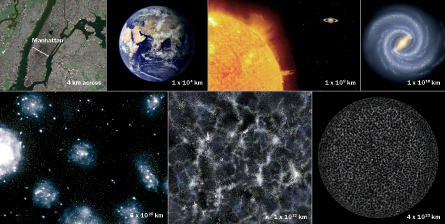Mission: reveal the secrets of the universe
The Objective
For millennia, people have turned to the heavens in search of clues to nature’s mysteries. Truth seekers from ages past to the present day have found that the Earth is not the center of the universe, that countless galaxies dot the abyss of space, that an unknown form of matter and dark forces are at work in shaping the cosmos. Yet despite these heroic efforts, big cosmological questions remain unresolved:
- What happened before the Big Bang?
- What is the universe made of?
- Is there a theory of everything?
- Are space and time fundamental?
- What is the fate of the universe?
The Vital Statistics
13.75 billion years (uncertainty +/–0.11):
Time since the Big Bang, the creation of the universe.
377,730 years (+3,205/–3,200):
Time after the Big Bang when photons stopped interacting with charged matter and produced the relic radiation known as the cosmic microwave background.
70.4 kilometers/second/megaparsec (+1.3/–1.4):
Expansion rate of the universe assuming its spacetime geometry is flat. Also known as the Hubble constant.
90 billion light-years:
Rough diameter of the known universe.
0.980 (+/–0.053):
Equation of state, a measure of the (negative) pressure exerted by dark energy divided by its density. An unvarying value of –1 suggests that dark energy is Einstein’s cosmological constant.
1.0023 (+0.0056/–0.0054):
Value of omega, the total mass-energy density relative to the critical mass-energy density. Omega equal to 1 signifies a universe with flat spatial geometry.
The Whereabouts
Understanding the universe requires recognizing its immense scale. Zooming out from Manhattan reveals the Earth, solar system, galaxies and then walls of galaxies separated by voids. At the most distant scales, the universe looks uniform.

Past Mission Findings
1543 Nicolaus Copernicus publishes a mathematical description of planetary motion, assuming that the sun is the center of the solar system. Later work by Johannes Kepler, Galileo Galilei and Isaac Newton provides further evidence.
1666 Isaac Newton formulates the law of gravity and laws of motion, published in 1687.
1900 Max Planck formulates the first description of quantum theory, which will eventually explain the nature of matter and energy on the subatomic scale.
1917 Albert Einstein applies general relativity to the universe. Later work by Willem de Sitter and independently by Aleksandr Friedmann implies the possibility that the universe is expanding.
1924 Edwin Hubble announces that the “spiral nebulae” sit beyond the Milky Way and later that the Milky Way is just one of many galaxies.
1929 Hubble finds that the universe is expanding, after analyzing the redshifts of distant galaxies.
1933 Fritz Zwicky examines galaxies in the Coma cluster and determines that there is unseen mass, what scientists call “dark matter.”
1960s Steven Weinberg, Abdus Salam and Sheldon Glashow independently propose a theory to unify electromagnetism and the weak nuclear force.
1964 Arno Penzias and Robert Wilson discover the cosmic microwave background radiation; in 1990 NASA’s COBE mission confirms that the radiation’s properties verify the universe’s birth in a Big Bang.
1986 Astronomers Margaret Geller, John Huchra and Valérie de Lapparent map a section of the observable universe, revealing a structure that encompasses large walls and giant voids.
1998 Researchers discover that the universe is expanding at an accelerating rate, suggesting a mysterious force dubbed “dark energy” might be at work.